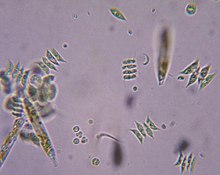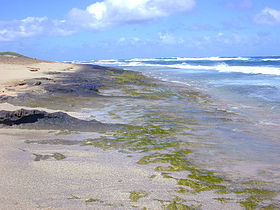Green algae
20.03
Diposting oleh zakky amarullah
The green algae (singular: green alga) are the large group of algae from which the embryophytes (higher plants) emerged.[1] As such, they form a paraphyletic group, although the group including both green algae and embryophytes is monophyletic (and often just known as kingdom Plantae). The green algae include unicellular and colonial flagellates, usually but not always with two flagella per cell, as well as various colonial, coccoid, and filamentous forms. In the Charales, the closest relatives of higher plants, full differentiation of tissues occurs. There are about 6,000 species of green algae.[2] Many species live most of their lives as single cells, while other species form colonies or long filaments.
A few other organisms rely on green algae to conduct photosynthesis for them. The chloroplasts in euglenids and chlorarachniophytes were acquired from ingested green algae,[1] and in the latter retain a vestigial nucleus (nucleomorph). Some species of green algae, particularly of genera Trebouxia and Pseudotrebouxia (Trebouxiophyceae), can be found in symbiotic associations with fungi to form lichens. In general the fungal species that partner in lichens cannot live on their own, while the algal species is often found living in nature without the fungus.
| Green algae | ||
|---|---|---|
 | ||
| Scientific classification | ||
| ||
| Included groups | ||
| ||
| Excluded groups | ||
|
Cellular structure
Almost all forms have chloroplasts. These contain chlorophylls a and b, giving them a bright green colour (as well as the accessory pigments beta carotene and xanthophylls),[3] and have stacked thylakoids.[4]
All green algae have mitochondria with flat cristae. When present, flagella are typically anchored by a cross-shaped system of microtubules, but these are absent among the higher plants and charophytes. Flagella are used to move the organism. Green algae usually have cell walls containing cellulose, and undergo open mitosis without centrioles.
Origins
The chloroplasts of green algae are bound by a double membrane, so presumably they were acquired by direct endosymbiosis of cyanobacteria. A number of cyanobacteria show similar pigmentation, but this appears to have arisen more than once, and the chloroplasts of green algae are no longer considered closely related to such forms. Instead, the green algae probably share a common origin with the red algae.
Classification

Green algae are often classified with their embryophyte descendants in the green plant clade Viridiplantae (or Chlorobionta). Viridiplantae, together with red algae and glaucophyte algae, form the supergroup Primoplantae, also known as Archaeplastida or Plantae sensu lato.
Classification systems which have a kingdom of Protista may include green algae in the Protista or in the Plantae.[5]
Phylogeny:[6]
| |||||||||||||||||||||||||||||||||||||||||||||||||||||||||||||
The orders outside the Chlorophyta are often grouped as the division Charophyta, which is paraphyletic to higher plants, together comprising the Streptophyta. Sometimes the Charophyta is restricted to the Charales, and a division Gamophyta is introduced for the Zygnematales and Desmidiales. In older systems the Chlorophyta may be taken to include all the green algae, but taken as above they appear to form a monophyletic group.
One of the most basal green algae is the flagellate Mesostigma, although it is not yet clear whether it is sister to all other green algae, or whether it is one of the more basal members of the Streptophyta.[1][7]

Reproduction
Green algae are eukaryotic organisms that follow a reproduction cycle called alternation of generations.
Reproduction varies from fusion of identical cells (isogamy) to fertilization of a large non-motile cell by a smaller motile one (oogamy). However, these traits show some variation, most notably among the basal green algae, called prasinophytes.
Haploid algae cells (containing only one copy of their DNA) can fuse with other haploid cells to form diploid zygotes. When filamentous algae do this, they form bridges between cells, and leave empty cell walls behind that can be easily distinguished under the light microscope. This process is called conjugation.
The species of Ulva are reproductively isomorphic, the diploid vegetative phase is the site of meiosis and releases haploid zoospores, which germinate and grow producing a haploid phase alternating with the vegetative phase. [1]
Posting Komentar